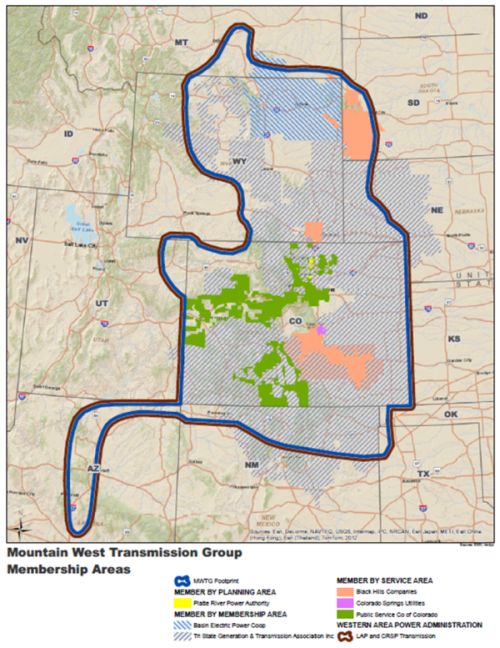
On January 6, 2017, following nearly four years of discussions, the entities comprising the Mountain West Transmission Group (MWTG) announced that they are exploring "potential participation with an existing regional transmission organization (RTO)." As a first step toward possible membership in an RTO, MWTG members announced that they will have further, detailed discussions with the Southwest Power Pool (SPP).
MWTG comprises cooperative, investor-owned, municipal, and federal electricity service providers serving nearly 4.5 million end-use consumers extending from Montana to New Mexico: Basin Electric Power Cooperative, Black Hills Power, Black Hills Colorado Electric Utility, Cheyenne Light Fuel & Power, Colorado Springs Utilities, Platte River Power Authority, Public Service Company of Colorado, Tri-State Generation and Transmission Association, and the Western Area Power Administration's (WAPA) Loveland Area Projects and Colorado River Storage Project. While originally focused on addressing the "rate-pancaking" issues resulting from the nine transmission tariffs that exist within the MWTG footprint, MWTG efforts expanded to consider a common transmission tariff without a wholesale electricity market and RTO membership with both a common tariff and a wholesale market.
In May 2016, MWTG issued a Request for Information (RFI) from RTOs interested in serving as a common tariff administrator as well as the possibility of integrating the MWTG members into an RTO market. MWTG received responses from the California Independent System Operator (CAISO), the Mid-Continent Independent System Operator (MISO), PJM Interconnection (PJM), and SPP. In parallel with the RFI process, MWTG undertook a transmission cost study and a projected market benefits study. These analyses concluded that there are potential costs savings associated with both a common tariff approach and RTO membership. At this time, the MWTG members have decided to focus on full membership in an existing RTO. If discussions with SPP do not lead to participation in that RTO, MWTG members have indicated that they may pursue similar discussions with MISO and/or PJM.
Since MWTG is an informal, voluntary organization, any ultimate decision to join an RTO will be made on a member-by-member basis and will be subject to relevant management, municipal, state, and federal approvals including the Federal Energy Regulatory Commission. MWTG members currently anticipate making a decision on RTO membership by mid-2017 with RTO market implementation projected in 2019.
If the MWTG members join SPP, they will bring with them a combined 15,700 miles of transmission lines extending from Arizona to Montana and will add portions of six states to SPP's overall footprint. This expansion would follow SPP's 2015 addition of the Integrated System consisting of WAPA-Upper Great Plains, Basin Electric Power Cooperative, and Heartland Consumers Power District. At the same time, SPP may be poised to continue its northern and western expansion; similar efforts by CAISO to develop a regional market remain paused following California Governor Jerry Brown's August, 2016, decision to require further study of the proposal. The proposed expansion of CAISO into a regional market would have added portions of Idaho, Oregon, Utah, Washington, and Wyoming, and may still come to pass following further discussions between California and the affected states and utilities which are anticipated for early this year.
Collectively, events of the last two years make it increasingly likely that the interior-West will no longer be the wild, untamed west as far as electricity markets are concerned. Despite ongoing uncertainties at the federal level with respect to environmental regulations and energy policy, electric utilities and other electricity service providers in the West appear to have concluded that coordinated, organized market activities will put them in the best position to manage those uncertainties and recognize economic savings as well as a wide variety of operational, reliability, and planning benefits.
The content of this article is intended to provide a general guide to the subject matter. Specialist advice should be sought about your specific circumstances.
We operate a free-to-view policy, asking only that you register in order to read all of our content. Please login or register to view the rest of this article.

